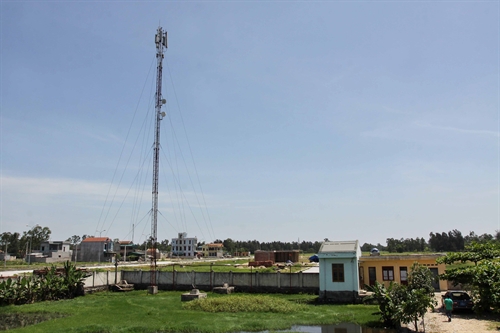 Economy
Economy

Nguyễn Xuân Quang, deputy director of the Hà Nội Department of Information and Communications, said that currently the sharing of BTS remain low
 |
| The base transceiver station (BTS) in Sầm Sơn Commune, Thanh Hoá Province. Telecom companies should use completed telecommunications infrastructure, such as base transceiver stations (BTS) and broadcast columns, for equipment installation and coverage in the Hà Nội area. – VNA/VNS Photo Minh Quyết |
HÀ NỘI (VNS) – Telecom companies should further jointly develop and use the completed telecommunications infrastructure such as base transceiver stations (BTS) and broadcast columns for equipment installation and coverage in Hà Nội area.
Nguyễn Xuân Quang, deputy director of the Hà Nội Department of Information and Communications, said that currently the sharing of BTS remain low, accounting for just 19 per cent. Therefore, Hà Nội should look for solutions to overcome this existing problem. Quang made the comment during a meeting to review the Law on Telecommunications and Law on Radio Frequencies.
He said that the city still faces barriers in encouraging telecom firms to share their network infrastructure. Although the city’s Department of Information and Communications had conducted numerous conferences to help telecom companies reach a consensus for common use of network infrastructure, it had failed to reach a consensus.
Quang attributed the negligible sharing of network infrastructure to the lack of sufficient and strict regulations that could compel them to do so.
In addition, a common urban infrastructure network had not yet become a requirement for the city’s development. Typically, the infrastructure network in high-rise buildings still lacked standard regulations thus causing difficulties for contractors in implementing their projects.
Quang said there was also no standardisation in the use of infrastructure network. Some were using optical fibre transmission lines, while others were still using copper cable transmission lines.
To encourage telecom firms to share the network infrastructure, the city administration needed to change the policy on the schedule to retrieve capital investment. It could be extended to between 30 years and 50 years, instead of 10 years to 15 years, currently.
This move will help minimise the cost of hiring infrastructure and thus will create favourable conditions for telecom businesses to join in.
Some industry insiders also proposed that the Ministry of Information and Communications needs to work with the Ministry of Construction to soon issue a joint circular that will specifically stipulate the issuance of construction certificates to telecom network projects.
On the other hand, the ministry also needs to study and add more standards on the construction of telecom equipment to be in sync with reality.
Quang said that in time to come, the department will continue to assist the city administration in offering incentives for telecom businesses to invest and build a telecom infrastructure network.
In 2014, the city was home to more than 5,700 BTS of all telecoms providers. Of them, 1,200 BTS share infrastructure network such as broadcast columns and antenna towers. – VNS




